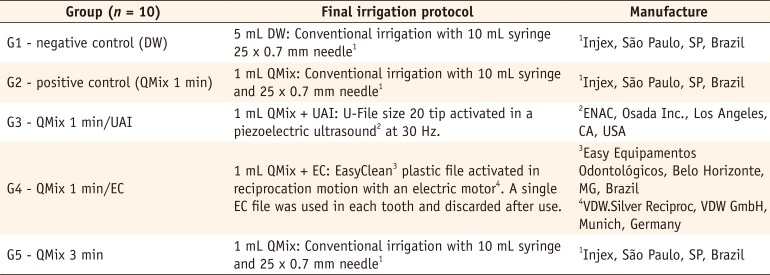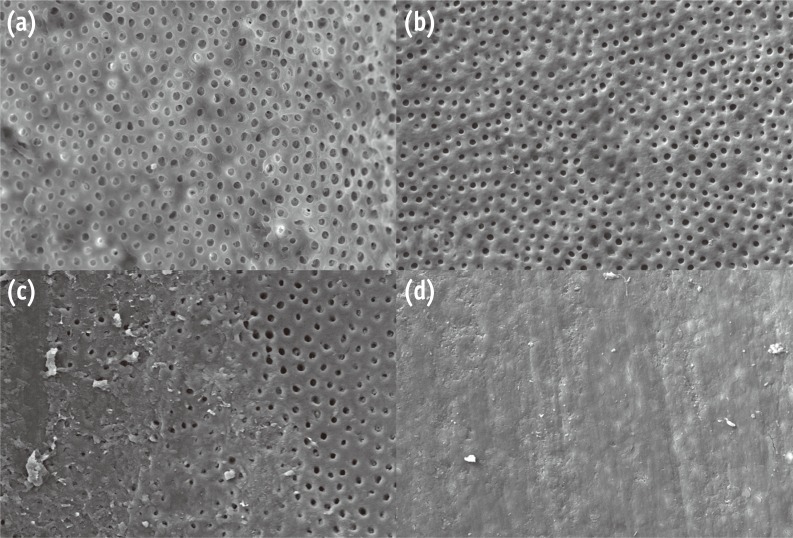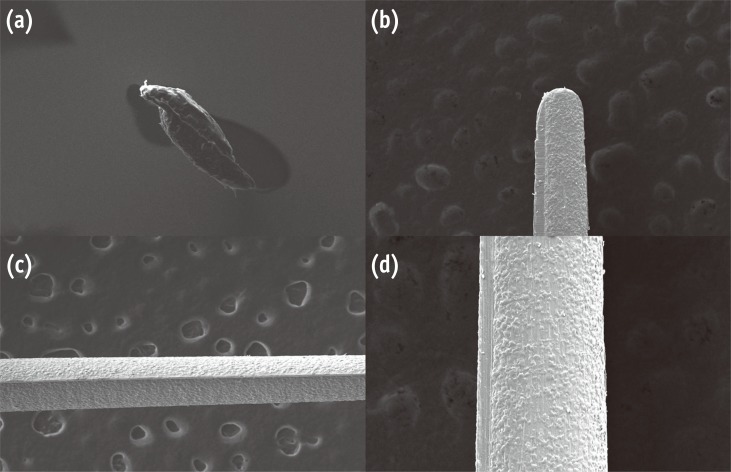Introduction
Irrigation of root canal system (RCS) is a crucial stage during endodontic therapy, as it allows cleaning and disinfection beyond the reach of mechanical activity of root canal instruments.
1 Effectiveness in the conventional irrigation technique by using syringe and needle depends on RCS anatomy and the depth of needle penetration according to root diameter and curvature.
2 This method is capable of inserting root canal irrigants to only 0 - 1.1 mm beyond the needle tip, and it is generally inefficient for reaching mechanically inaccessible regions and the apical root third.
13
Effective action of irrigating solutions is achieved by direct contact with dentin walls.
2 This contact may be restricted by the presence of smear layer (SL) and debris, irrigation method, and/or root canal anatomy, mainly in the apical region.
14567 Therefore, different auxiliary devices and irrigation techniques have been proposed, not only to improve the flux distribution of irrigants, but also to increase their action in RCS.
891011
The use of passive ultrasonic irrigation produces and transmits acoustic energy by ultrasonic waves from an oscillating file or smooth wire, creating cavitation, and acoustic streaming that increases the effect of irrigants on root canal walls and in mechanically inaccessible areas.
212 As this process is in fact active, the term ‘passive’ does not correctly describe the technique;
12 thus, the term ‘ultrasonically activated irrigation (UAI)’ has been used.
An acrylonitrile butadiene styrene (ABS) plastic endodontic finishing instrument, with a size of 25/0.04, named EasyClean (EC, Easy Equipamentos Odontológicos, Belo Horizonte, Minas Gerais, Brazil) was recently designed to increase the activity of root canal irrigants. As EC operates in reciprocating motion (180° clockwise turn, followed by a 90° counterclockwise turn), this kinematic model may avoid file fracturing or locking within the canals.
13 A recent study concluded that the reciprocating activation of EC with 17% ethylenediaminetetraacetic acid (EDTA) was effective for debris removal from the more apical regions of root canals.
13 Therefore, this reciprocating system may yield a further advantageous option among the available auxiliary irrigation devices.
The aim of this study was to evaluate the cleaning ability of UAI and a novel activation system with reciprocating motion (EC) in all root canal regions, when used with a relatively new chelating agent, QMix 2in1 (Dentsply, Tulsa Dental Specialties, Tulsa, OK, USA), as the final irrigation protocol of endodontic therapy. In addition, the effect of QMix solution when used for a shorter (1 minute) and a longer application time (3 minutes) was investigated. The null hypotheses tested were: (1) There were no differences in the cleaning ability among all irrigation protocols; (2) There were no differences in the cleaning ability between UAI and EC devices; (3) There was no difference in the cleaning ability of QMix when used with conventional irrigation in comparison with using it with auxiliary devices.
Go to :

Materials and Methods
Sample selection and preparation
This study was approved by the University Ethics Committee (Protocol: 27745514.0.0000.5259). Fifty single-rooted anterior teeth with single canal and straight roots were selected for this study. The presence of immature root, root damage, calcifications, atresic root canals, or root length shorter than 13 mm were established as the exclusion criteria. Using a diamond disc, the selected teeth were sectioned at 12.5 mm from the anatomic apex, and two longitudinal grooves were prepared in the mesial and distal regions of roots to facilitate later splitting of the samples. After this, patency of all specimens was confirmed with a size 10 K file (Dentsply Maillefer, Rio de Janeiro, RJ, Brazil) and the apical foramen was standardized with a size 25 K file (Dentsply Maillefer).
Chemomechanical preparation
The samples were chemomechanically prepared with the K3 rotary system (SybronEndo, Orange, CA, USA) and 6% sodium hypochlorite (NaOCl) solution as chemical auxiliary substance. The working length was established at the total root length, in the apical foramen. To ensure that instrumentation occurred in a closed system, the apex was sealed with utility wax. A closed system enabled the authors to simulate clinical conditions, avoiding irrigant extrusion through the apical foramen and inducing production of the vapor lock phenomenon; thus allowing more reliable results. The K3 NiTi instruments were used in the following order (size/taper): 25/0.06 in the cervical and middle thirds; and 15/0.04, 20/0.02, 20/0.04, 25/0.04, 20/0.06, and 25/0.06 in the apical region. Between each file change, 1 mL of NaOCl was inserted with a syringe and needle (10 mL syringe with 25 x 0.7 mm needle) and patency was confirmed with a size 10 K file (Dentsply Maillefer).
After preparation, 10 mL of distilled water (DW) was used to neutralize any traces of NaOCl, and samples were randomly assigned to five groups (
n = 10) according to the final irrigation protocol (
Table 1): G1, negative control (DW); G2, positive control (QMix 1 minute); G3, QMix 1 minute/UAI; G4, QMix 1 minute/EC; G5, QMix 3 minutes. In G1, the negative control group, DW was used alone at the final rinse; thus, SL was not removed. In G2, G3, and G4, QMix was used for 1 minute, as this is the minimum time required for this solution to act, according to manufacturer, allowing clinical optimization of final rinsing. However, in contrast to G3 and G4, no auxiliary irrigation device was used in G2, denominated the positive control group. In G5, QMix was used for a longer time (3 minutes) with no auxiliary irrigation device, allowing the authors to analyze whether an increase in application time of this irrigant could compensate the non-use of UAI or EC and yield satisfactory results.
Table 1
Distribution of groups according to the final irrigation protocol in root canal cleaning and shaping

|
Group (n = 10) |
Final irrigation protocol |
Manufacture |
|
G1 - negative control (DW) |
5 mL DW: Conventional irrigation with 10 mL syringe 25 × 0.7 mm needle1
|
1Injex, São Paulo, SP, Brazil |
|
G2 - positive control (QMix 1 min) |
1 mL QMix: Conventional irrigation with 10 mL syringe and 25 × 0.7 mm needle1
|
1Injex, São Paulo, SP, Brazil |
|
G3 - QMix 1 min/UAI |
1 mL QMix + UAI: U-File size 20 tip activated in a piezoelectric ultrasound2 at 30 Hz. |
2ENAC, Osada Inc., Los Angeles, CA, USA |
|
G4 - QMix 1 min/EC |
1 mL QMix + EC: EasyClean3 plastic file activated in reciprocation motion with an electric motor4. A single EC file was used in each tooth and discarded after use. |
3Easy Equipamentos Odontológicos, Belo Horizonte, MG, Brazil |
|
4VDW.Silver Reciproc, VDW GmbH, Munich, Germany |
|
G5 − QMix 3 min |
1 mL QMix: Conventional irrigation with 10 mL syringe and 25 × 0.7 mm needle1
|
1Injex, São Paulo, SP, Brazil |

In the groups in which conventional irrigation was used at the final rinse (G1, G2, and G5), the needle was introduced in the middle third of specimens. In the groups in which auxiliary irrigation device were used during the final irrigation protocol (G3 and G4), the needle was introduced in the middle third of specimens and EC or UAI were inserted into the apical third of specimens. The UAI was performed with a piezoelectric ultrasound machine (ENAC, Osada Inc., Los Angeles, CA, USA) set at 30 Hz, which provided an ultrasonic activation power of irrigants. As regards the use of EC, an electric motor (VDW.Silver Reciproc, VDW GmbH, Munich, Germany), in reciprocation motion, was used, providing agitation of QMix with this kinematic model. Afterwards samples received a final rinse with 10 mL of DW and were dried with absorbent paper points.
Scanning electron microscopy analysis
Samples were longitudinally split into two root halves through the previously prepared grooves, and the most preserved portion was sputter coated with gold for analysis. Then, each root was figuratively divided into three parts measuring 4 mm, equivalent to the cervical, middle and apical root thirds. According to a previous study, three representative images (magnification ×1,000) were prepared in each root third of samples by scanning electron microscopy (SEM, JSM 6460 LV, JEOL, Tokyo, Japan) at 20 KV.
14 Thus, nine images were prepared for each sample, totaling ninety images per group for evaluation.
The SEM images obtained were evaluated by two blinded and previously calibrated examiners. The cleaning ability of irrigation protocols was based on a four categorical scoring system (
Figure 1), through qualitative analysis of the existing amounts of SL and debris on the root canal walls and dentinal tubules: Score 1, complete absence of SL or debris; Score 2, the largest part of the root surface without SL and debris; Score 3, the largest part of the root surface covered with SL and debris; Score 4, root surface completely covered with SL and debris without any visible dentinal tubules.
14
 | Figure 1Representative images of the Score system attributed to SEM images (×1,000). (a) Score 1, complete absence of SL or debris; (b) Score 2, most part of root surface without SL and debris; (c) Score 3, most part of root surface covered by SL and debris; (d) Score 4, root surface completely covered by SL and debris with no visible dentinal tubule. SL, smear layer.
|
Statistical analysis
Kappa test was carried out to analyze the interexaminer reliability regarding SEM images. The non-parametric Kruskal-Wallis and Dunn post hoc tests were applied, at a 5% significance level (p < 0.05), to detect statistical difference between the groups.
Go to :

Results
The Kappa test indicated an excellent agreement between examiners (value of 0.93). All groups presented residual SL and debris on root canal walls and dentinal tubules. No significant erosion was observed in the samples.
Table 2 summarizes the values of SL scores presented by each group and root thirds, with the statistical difference between them. There were differences in the cleaning ability among the irrigation protocols (Kruskal-Wallis test;
p < 0.05). The UAI group presented the lowest SL scores and superior results in comparison with those of the other groups evaluated (
p < 0.05).
Table 2
First quartile/median/third quartile values of smear layer scores

|
Group / Thirds |
1
Negative Control (DW) |
2
Positive Control (QMix 1 min) |
3
QMix 1 min/UAI |
4
QMix 1 min/EC |
5
QMix 3 min |
|
Cervical |
3/4/4Ad
|
2/2/2Ac
|
1/2/1Aa
|
2/2/2Ab
|
2/2/2Ab
|
|
Middle |
3/3/4Ad
|
2/3/2Bc
|
1/2/1Aa
|
2/3/2Ab
|
2/2/2Ab
|
|
Apical |
3/4/4Bb
|
3/4/3Cb
|
2/3/2Ba
|
2/3/2Ba
|
2/3/2Ba
|
|
All thirds |
3/4/4d
|
2/3/4c
|
1/2/2a
|
2/3/3b
|
2/2/3b
|

The cleaning ability of UAI was statistically superior to that of the EC device (Dunn test; p < 0.05). Furthermore, there was an improvement in the cleaning ability of QMix when used with auxiliary devices in comparison with conventional irrigation in the same period of time (Dunn test; p < 0.05). Finally, EC group and QMix 3 minutes showed similar results (Dunn test; p > 0.05) and the conventional irrigation with QMix for 3 minutes presented significantly better results than its use for 1 minute (Dunn test; p < 0.05).
Go to :

Discussion
All groups presented residual SL and debris on root canal walls and in dentinal tubules, in agreement with the overall findings in endodontic literature.
810111516 Although the goal of the final rinse was complete removal of the SL, it seemed to be virtually impossible to achieve the objective by means of all the available techniques. Nevertheless, maximum cleaning of the root canals should be reached without causing the erosion of dentinal tubules, since the presence of SL and debris reduced the effectiveness of disinfecting agents and interfered in the adhesion of filling materials.
4617
Statistically significant differences were observed among groups (
p < 0.05). Consequently, the first null hypothesis that ‘there was no difference in the cleaning ability among all irrigation protocols’ was clearly rejected. The use of UAI demonstrated the best results, followed by EC and QMix 3 minutes, which presented similar scores. Indeed, the excellence of UAI could not be regarded as a novelty, because it has been well documented in the literature.
1218
QMix agitated with the EC system led to less effective results, probably because this device may reduce the phenomena of acoustic streaming (fast vortex kinematics) and cavitation (creation of steam bubbles or the expansion, contraction and/or distortion of pre-existing bubbles in a liquid) compared with ultrasonic irrigant activation.
12 Therefore, the second null hypothesis that ‘there were no differences in cleaning ability between the UAI and EC devices’ was also rejected.
The increase in the application time of QMix up to 3 minutes, without auxiliary devices, yielded similar results to those of the EC group, in which QMix was used for 1 minute. Chelation action of QMix must have been enhanced with time, so that it achieved its optimal effect after 1 minute. This finding may suggest that the absence of an auxiliary device could be compensated by increasing the time of action of this solution. However, the toxic effect of an agent may increase with time and thus the application time of irrigants must be selected with caution.
An increase in the application time of UAI and EC devices may yield better cleaning ability. However, as auxiliary devices increase the flux and effectiveness of irrigants, the use of these devices in association with longer application time of solutions could significantly raise further risks of dentin erosion and toxic effects.
891011 Therefore, the time used during irrigant activation should be the minimum required for effective results. As an adequate performance was obtained by using UAI for 1 minute, it is unnecessary to increase the application time of QMix with this device. Nevertheless, when associated with EC, a slight increase in the application time of QMix, such as adding 30 seconds, could be interesting to obtain better results. Further researches are required to confirm this assumption.
As regards the cleaning potential of irrigation protocols in the critical apical area, G1 (negative control - DW) and G2 (positive control - QMix 1 minute) presented the worst results, whereas G3 (QMix 1 minute/UAI), G4 (QMix 1 minute/EC) and G5 (QMix 3 minutes) groups showed similarly improved results. The use of QMix for 1 minute was not effective for SL removal in the apical area. As previously stated, QMix probably achieved its optimal effect after 1 minute; however, this application time was insufficient for obtaining effective SL removal in the apical third. Moreover, specifically in this region, G3 (QMix 1 minute/UAI) and G4 (QMix 1 minute/EC) showed similar results. This can be explained because both systems allowed agitation of the solution associated with elimination of the vapor lock phenomenon, improving the irrigant effectiveness. In this aspect, Kato et al.
13 observed superior cleaning ability results in the apical region for EC in comparison with UAI. The differences in results can be explained by the methodology. The authors of the cited study used the mesiobuccal root canals of mandibular molars and previously prepared cleaved specimens, while in the present study we used unirradicular teeth and the teeth were cleaved after preparation.
EC is composed of ABS plastic, which reduces or even prevents damage when it comes into contact with the root canal walls. This material also provides the instruments with flexibility, allowing it to be used right up to the working length, possibly even in the presence of curvatures.
13 Moreover, the EC file presents a particular ‘aircraft wing’ design, characterized by a central matrix associated with two delicate edges throughout the instrument (
Figure 2). These combined design features generate two mechanisms of action, that is, the well-known agitation of solutions, which disperses forces within the canal, and direct contact with the root walls that allows mechanical drag of the adhered debris and biofilms.
13
 | Figure 2Photomicrographs of EasyClean. (a) Cross-sectional image of the instrument tip, showing two edges in opposite sides of EasyClean (×150); (b - d) EasyClean instrument body (×50).
|
Sodium hypochlorite (0.5 - 6%) is the most widely used chemical auxiliary substance during root canal cleaning and shaping, because it presents a considerable body of supporting evidence.
519 At the final rinse, EDTA (15 - 17%) is usually associated with NaOCl for SL removal, leading to an undesirable formation of chlorine gas, a toxic by-product.
1920 Therefore, intermediate flushes with distilled water should be performed to prevent or at least reduce the formation of this by-product.
20 QMix 2in1, which is a one-step, ready-to-use solution composed of EDTA and chlorhexidine,
17 effectively removes the inorganic portion of SL and kills bacteria,
421 thereby optimizing the final irrigation protocol and avoiding the formation of chlorine gas during root canal therapy.
QMix solution effectively removed SL in the total area of root canals since all experimental groups presented results that were superior to those of the Negative Control group, in which only DW was used in the final irrigation protocol. However, the method of application of this irrigant must be reviewed. Despite the manufacturer's indication to use QMix for 60 - 90 seconds, the ability of this solution was only effective for cleaning the apical region in this minimum time interval when associated with auxiliary irrigation devices. Hence, the third null hypothesis tested that ‘there were no differences in the cleaning ability of QMix when used with conventional irrigation in comparison with its use with auxiliary devices’ was rejected. The agitation of QMix increased the flux and distribution of this solution, reflecting in cleaner root canal walls and dentinal tubules in apical region.
Go to :








 PDF
PDF ePub
ePub Citation
Citation Print
Print



 XML Download
XML Download